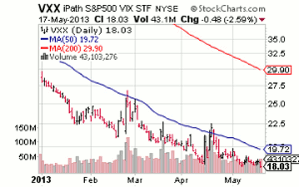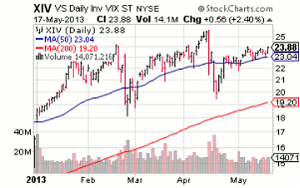The VIX Index is near historic lows as complacency runs high, writes John Nyaradi of Wall Street Sector Selector, as he offers long and short plays based on the VIX’s future direction.
In recent days, the VIX index, the CBOE S&P 500 Volatility Index, also known as the fear index, has dipped back into extremely low territory, indicating high investor complacency and confidence in the short-term future of low volatility and higher stock market prices. Today’s low volatility and readings in the VIX index is a result of investors anticipating continued Federal Reserve intervention in the markets. The current situation has driven the VIX index to the 12-13 level in recent days, a level near the index’s historical lows.
VIX is widely viewed as a way to measure market risk and forecast future stock price movements. Some observers say that when the VIX index is low, market risk is low, and prices are likely to trend higher. This camp also says that when the VIX is high, lower prices are ahead as fear is the dominating force in the market.
Contrarians say to “sell the greed, buy the fear” and so when the VIX index is low, contrarians would be anticipating declines in stock prices ahead and selling long positions or going short. When the VIX is high, they would be expecting a reversion to the mean and entering long positions.
This correlates to Warren Buffet’s famous advice, “be fearful when others are greedy and greedy when others are fearful.” Right now, greed is dominating global market places and so perhaps the foxy old Oracle of Omaha would be saying that now is time to be fearful instead of greedy and complacent.
If you’re interested in trading the VIX on the long side, a popular choice is iPath S&P 500 Short Term Futures ETN (VXX).

Chart Courtesy of Stockcharts.com
Click to Enlarge
NEXT PAGE: Long & Short Plays on the VIX
|pagebreak|In this chart, we can see how the iPath S&P 500 VIX ETN (VXX) has declined sharply year-to-date and is now well below its 50-day and 200-day moving averages and bouncing along at recent lows. Although this is a high volume, popular ETN, it has significant tracking error problems and suffers from what’s known as “contango,” wherein prices of the underlying futures contract go steadily higher over time and so the ETN will constantly lose money unless volatility takes a sharp spike. This ETN is suitable for short-term holding periods only.
On the “short” side of VIX, is Velocity Shares Daily Inverse VIX Short-Term ETN (XIV) This ETN is designed to inversely track the volatility in the markets as measured by the S&P 500 VIX Short-Term Futures Index. It is designed to rise in price as the VIX index declines and does not have as much tracking error as seen in other VIX products. Nevertheless, it, too, is subject to wild swings in price and will typically gain in value as the S&P 500 gains in value and volatility declines.

Chart Courtesy of Stockcharts.com
Click to Enlarge
In this chart of XIV, we can see how it has gained more than 30% since the start of 2013 but has also had two bouts of steep declines in the neighborhood of 20%.
VIX currently continues to plumb low levels as investors anticipate further central bank support in spite of recent dialogue from various Fed members that the Fed should start cutting back on its quantitative easing programs. Fiscal policy from the sequestration will also serve to be a drag on the economy, along with the recession in Europe. Global central bank action will continue to set the tone for the stock market going into summer as monetary intervention works to offset a slowing global economy.
Bottom line: Low VIX generally means higher equity prices and vice versa, and so investors and traders will be paying close attention to all of these events. Markets are overstretched and overbought and so a spike in volatility would not be a surprise, particularly since no one is expecting such a move. So, indeed, VIX could be forecasting a stock market surprise.
By John Nyaradi, Publisher, Wall Street Sector Selector





















